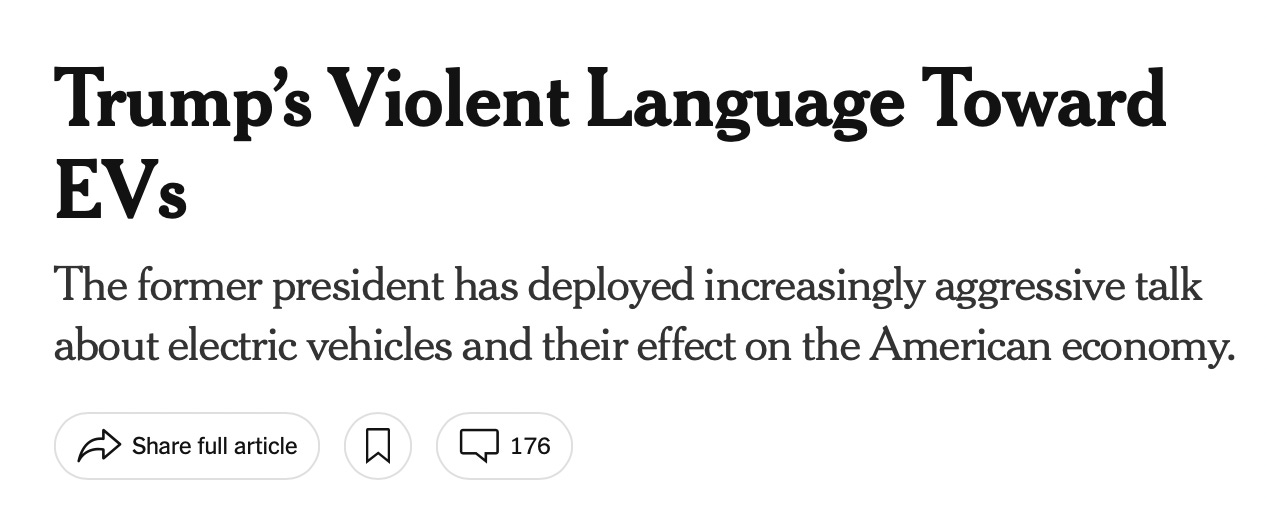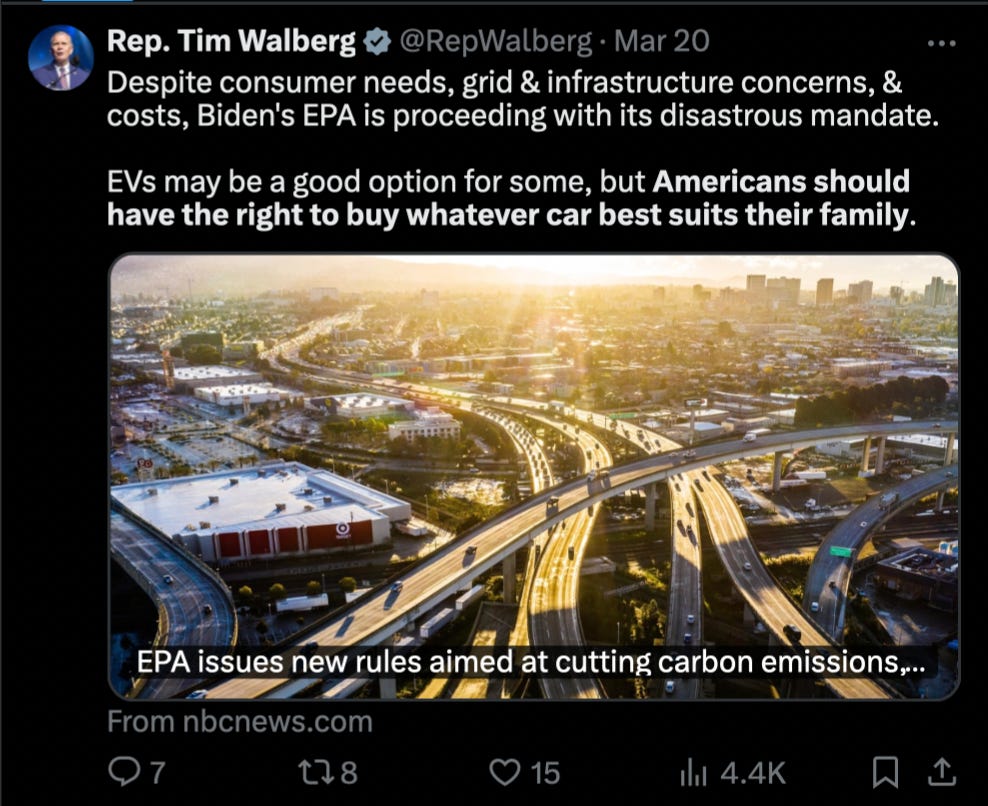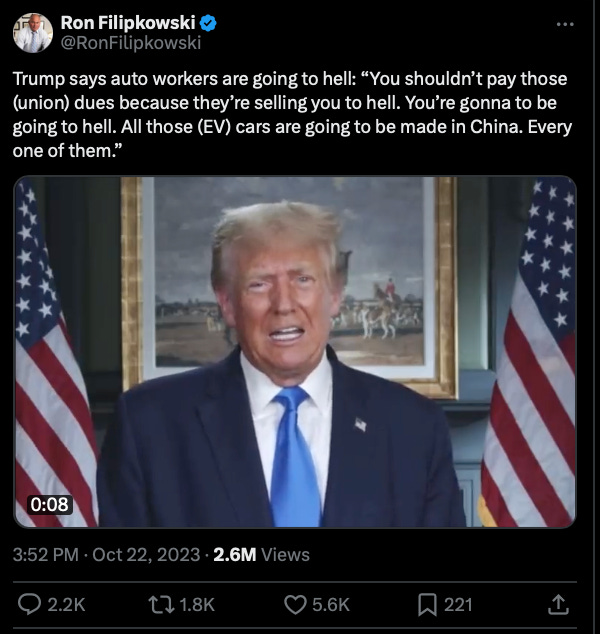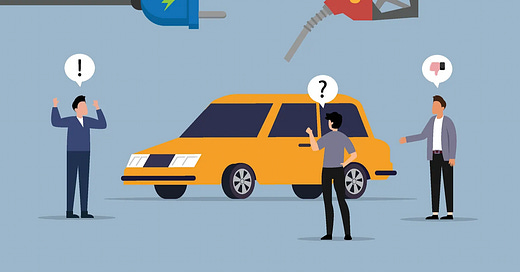A guide to electric car misinformation (part 1)
The 2024 election is becoming all about EVs — which is terrible news for public understanding about them.
The closer we get to the 2024 presidential election, the more sketchy information you’re going to hear about electric cars.
Both Joe Biden and Donald Trump have decided to make electric cars central to their campaigns. Biden is doing this by promoting his administration’s efforts to expand EV production and ownership, and Trump is doing this by attacking those efforts.

GOP polling has shown that attacking electric vehicle policy has been “amazing” for Republicans, former Trump energy advisor Michael McKenna recently told the New York Times. And Biden’s EV policies have drawn praise from both green groups and the United Auto Workers union—two important political constituencies.
So the EV political discourse isn’t likely to die down soon, which is generally bad news for public understanding. Because political actors aren’t primarily motivated by helping you understand reality; they’re primarily motivated by inflaming or exciting you into making a certain political decision.
So, with that in mind, I thought it might be a good time to go over some of the most common myths and generally misleading claims about electric vehicles that I’ve been hearing from both sides of aisle lately.
I’ll get through a few examples today, and give you a few more early next week. Today’s examples will be specifically about what the Biden administration is doing surrounding EVs. Next week, we’ll dive into some more general information.
If you’re a subscriber and there’s something you really want to see covered, let me know in the comments.
Myth: Biden is banning gas cars; taking away gas cars; or preventing the sale of gas cars.
Of all the attacks Republicans are making against electric vehicles, the idea that Biden is mandating which cars American consumers can buy is “especially potent,” political analysts recently told the New York Times.

It’s so potent that even the New York Times op-ed section has been fooled by it. In a recent column, Ross Douthat complained that Biden’s new EPA regulations tell American consumers: “If you like your [gas-powered] car, I don’t want you to keep it.”
This is, at best, highly misleading. Biden’s new EPA pollution standards for cars, released last week, say literally nothing about what Americans can or cannot buy. They also say literally nothing about what Americans can or cannot own.
The new EPA pollution standard requires carmakers to reduce the average climate impact of their entire new product lines, starting in 2027 and increasing through 2032.
This doesn’t mean carmakers will have to switch to making only all-electric vehicles. It means they will likely have to make more electric, hybrid, and perhaps hydrogen-powered vehicles, and less gas-powered vehicles, to comply with the new emissions standard.
What’s true is that the new pollution standards will have an impact on the make-up of new cars that are sold in the future. The EPA estimates that by 2032, “about 56 percent of new passenger vehicles sold would be electric and another 16 percent would be hybrids.“ That’s a big increase from current rates; in 2023, only about 8 percent of new vehicles sold were electric. (Electric car sales in 2023 were, however, about 54 percent higher than in 2022, according to Wards Auto Data).
But the regulation does not prevent the sale of gas cars. About 30 percent of new vehicles sold will still be gas-powered; a huge percentage of used vehicles sold will be gas-powered (the regulation does not apply to used cars); and no one will be required to give up their gas car.
While some Republicans concede that the rule may not be an outright ban, they still say it constitutes a “shadow-ban.” Former Trump energy advisor Michael McKenna said this to the New York Times, reasoning, “If you make something unavailable it’s the same as banning it.”
But Biden’s regulation does not make gas cars unavailable. It means that, in about 8 years, new gas-powered vehicles will be less prolific than they are today. Whether that’s good climate policy is a separate question. But anyone attempting to tell you that gas vehicles will be banned or pulled out of your driveway is either misinformed or trying to inflame you for political purposes.
Myth: Electric cars are “all going to be made in China"
Another major talking point among Republicans attacking Biden’s electric car push is that it’s a major giveaway to China.

Trump himself has said that a second Biden term would result in a “bloodbath” for the U.S. auto industry because Biden will allow Chinese EVs to flood the market. He recently said that EVs in the U.S. are “all going to be made in China.”
The threat to American automakers from Chinese EV companies is real. But the idea that the Biden administration is simply sitting back and allowing Chinese EVs to flood the U.S. is not. (Though many EV enthusiasts and some climate advocates wish it were, because China has some of the cheapest and fastest-charging electric cars on the market).
The reality is, as the Wall Street Journal recently reported, “Washington has effectively built a fortress to keep out Chinese EVs”:
Former President Donald Trump imposed a 25 percent tax on Chinese auto imports. President Biden backed that policy and went further, denying them “Buy America” credits that can reduce consumers’ price tag by thousands of dollars.
These steps have made it virtually impossible for Chinese automakers to compete with vehicles built in the U.S. or imported from friendly nations, even as they rapidly penetrate other markets.
It’s still possible that Chinese automakers will eventually be able to break through these policy barriers. As Politico recently reported, “the average price gap between a Chinese vehicle and its U.S.-made counterpart ranges from 44 percent to 179 percent,” which means the current 27.5 percent tariff may still not be preventative enough.
But the Biden administration knows this, so it is going even further. As Robinson Meyer reported earlier this month in Heatmap, the Biden administration recently opened up an investigation into Chinese-made vehicles that connect to the internet. The investigation marks “the first part of what is likely to be a broad American policy response to the rise of Chinese electric vehicles,” Meyer wrote, and “is a big deal, in part because it marks that the backlash to Chinese EVs has begun in earnest in the U.S.”
The EPA regulations can be seen as part of that backlash. They are as much an attempt to pressure U.S. automakers to beat China at the EV game as they are an attempt to reduce emissions. Whether that’s good climate policy is, again, a separate question—but as Phoebe Wall Howard recently wrote in the Detroit Free Press: “If North American and European companies don't focus on pushing forward [on EVs], other countries will come in and eat their lunch. There will be no coming back from that.”
Anyone trying to tell you that the Biden administration is sitting back and allowing Chinese EVs to destroy the American auto industry for the sake of the climate is either misinformed or trying to inflame you for political purposes.
Misleading: Biden’s EPA rule is the “strongest-ever” climate standard for cars.
I’m labeling this claim “misleading,” and not a “myth,” because it is technically true. The Biden Administration’s new pollution standard is technically the strongest climate regulation ever issued for the transportation sector, which is responsible for more carbon emissions than any other sector of the U.S. economy.
But when it comes to evaluating a climate policy, words like “strongest-ever” and “historic” should always raise red flags. They are essentially marketing terms, intended to make you feel super hyped about something that, in reality, could be pretty “meh.” Remember: “Strongest-ever” does not mean “appropriate” or “effective” in tackling the climate crisis. It just means it does more than has been done before, which in the case of U.S. climate action, is very little.
The things I explained in the previous two sections—that the new EPA standards don’t actually ban gas cars, and that they don’t actually allow Chinese EVs to flood the U.S. market—are great for the U.S. auto industry. They are not, however, best-case-scenarios for the global climate.
To secure a safe and stable climate, climate scientists say the world must achieve net zero emissions by 2050. Achieving that for the transportation sector requires massive investments in public transit and biking infrastructure so that people simply drive less—but it also that means 90 percent of of U.S. vehicles must be electric by 2050, and sales of all new gas vehicles must cease by 2038 at the latest (This is according to University of Toronto research and BloombergNEF).
The Biden administration’s new EPA rules are “objectively ambitious,” the New York Times reported. They are “projected to eliminate more than seven billion tons of carbon dioxide from the atmosphere over the next 30 years, more than all the greenhouse gases produced by the entire United States economy in one year.” That’s way, way better than where we’re currently at.
But the rules don’t actually get us to where we need to be. As the Los Angeles Times editorial board wrote last week, “We’re in the race of our lifetime against climate change and President Biden is driving way below the speed limit.”
Anyone trying to convince you that Biden is effectively tackling the climate crisis with his “strongest-ever” EPA rules is either misinformed or trying to excite you for political purposes.
Stay tuned until next week for more.
Further reading:
Why EVs Aren't a Climate Change Panacea.
"For EVs themselves to become true zero emission vehicles, everything in their supply chain from mining to electricity production must be nearly net-zero emission as well. Today, depending on the EV model, where it charges, and assuming it is a battery electric and not a hybrid vehicle, it may need to be driven anywhere from 8,400 to 13,500 miles, or controversially, significantly more to generate less GHG emissions than an ICE vehicle. This is due to the 30 to 40 percent increase in emissions EVs create in comparison to manufacturing an ICE vehicle, mainly from its battery production.” - IEEE Spectrum, January 2023.How did China come to dominate the world of electric cars?
“Several experts tell MIT Technology Review that the government has long played an important role—propping up both the supply of EVs and the demand for them. As a result of generous government subsidies, tax breaks, procurement contracts, and other policy incentives, a slew of homegrown EV brands have emerged and continued to optimize new technologies so they can meet the real-life needs of Chinese consumers. This in turn has cultivated a large group of young car buyers.” - MIT Technology Review, February 2023.Trump’s attacks on Chinese cars strike a chord — with both parties.
“Former President Donald Trump’s pledge to slap a 100 percent tariff on Chinese vehicle imports aligns with a rise in anxiety in Washington about the growing might of Beijing’s auto industry — with both Democrats and Republicans clamoring for drastic steps to save American jobs.” - Politico, March 2024.
Catch of the Day: Reader Chloe is grateful that we attempt to balance out the heaviness of our content with this section—and is pleased to introduce her dawghter, Phoebe Adele Winifred Schooler.
Phoebe is all about preventing food waste by eating her brother's food. And leaves. Delicious, wet leaves.
Want to see your furry (or non-furry!) friend in HEATED? It might take a little while, but we WILL get to yours eventually! Just send a picture and some words to catchoftheday@heated.world.






This article showed up as I was researching new cars...hybrid and electric! I am having a hard time deciding...the reality for me is that I am somewhat confused by the rebates, the cars, the standard and add on options, and the reviews. I am looking forward to your next article on this topic...I'll keep researching until then. Very sad that we, as a country and planet, can't get behind saving the planet by doing some smart things...like getting EVs and hybrid vehicles.... it may prove to be our and the planet's undoing. Keep up the great journalism!
Emily, I was hoping that you would also address another issue that's received a lot of media attention. That's the increase in electricity generation. EVs play into that but I wonder how much infrastructure needs to be updated to accomodate a massive increase in EV sales.